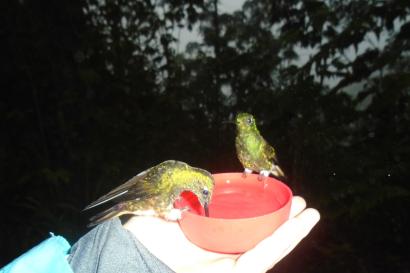It’s surreal to me that I have now spent two months of my life on the Island of San Cristóbal. Although I have visited several other islands, this island is near and dear to my heart. It’s where I got my first sunburn, ate my first sea snails, and of course, saw my first boobies (the blue-footed versions, of course). Although the atmosphere is very laid back, I have been lucky enough to travel all around the island and experience what this wonderland has to offer.
One night, we camped at Puerto Chino, a postcard beach with pillows for sand. That is, they were pillows until the sand got packed down, but that did ensure that I was awake to view the stars blanket over us, the moon rise over the ocean horizon, and the splendid morning sunrise. There were large night herons, brown pelicans, sea lions, and many blue-footed boobies around to enjoy these sights with us. Just after the sun was past the horizon, around 20 blue-footed boobies began their morning feast. In rapid succession, they soared around 50 feet in the air before suddenly plunging into the wake, often gulping down the fish they had just caught. It is unbelievable how streamlined these goofy birds were able to become just before crashing into the surface.
For a field trip with my Political Ecology class, we took a boat around the entire island. Our two main stops were Playa Rosa Blanca and the lagoon there and la Roca Leòn Dormido. Rosa Blanca was the most tropical oasis-looking beach I have been to as of yet, and the sand somehow has the consistency of powdered sugar. One of our main reasons for visiting here is that due to currents, it has become a large collection site for trash, which we did our best to clean up. I will definitely have to write a post about these issues soon. Leòn Dormido might be the most famous site in San Cristóbal. It is a huge rock outcropping just off the coast that looks similar to a sleeping lion, hence its name. However, it is most famous for its diving and snorkeling intrigues, as we saw several schools of hammerhead, black-tip, and Galápagos sharks. There is nothing more shocking and thrilling to be surrounded by almost a hundred sharks. How many other study abroad experiences or even just places in the world offer this?
On another field trip with the Political Ecology class, we visited la Galapaguerra and el Junco, which are the island’s tortoise breeding facility and a huge volcanic crater lake, respectively. The tortoises were very active and plentiful here, and with many other places I have been to here, I reverted back to a childlike state of glee. It is a dream come true to see these creatures breathe in real life. El Junco was also a marvel. Although we didn’t complete it, it was a two- or three-mile hike around the rim. Frigate birds swarmed over, often skimming the surface to pluck fish out of the water before doing a funny little jig to shake the water off of them.

Thomas Hotaling
<p class="MsoBodyText" style="margin-top:.4pt; margin-right:21.05pt; margin-bottom:.0001pt; margin-left:5.5pt"><span style="line-height:103%">Hello! My name is Thomas, and I’m from St. Louis, Missouri and currently am a second year at Case Western Reserve University. I like to think of myself as an avid outdoorsman, and you can often find me backpacking or just having fun outside, and I’m even a summer camp nature counselor. I'm currently studying environmental geology because rocks are the absolute coolest, and if you don't believe me I'd be happy to share my opinions with you.</span></p>








